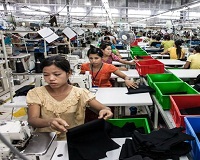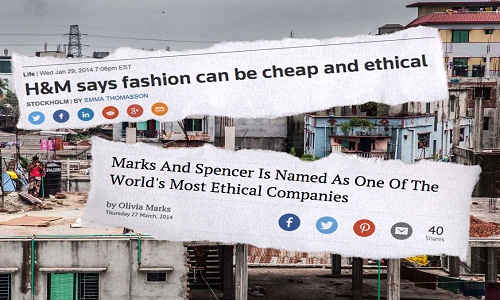"While leading companies have taken efforts to curb issues of worker underpayment, yet the goal seems too far-fetched. As the world’s second-largest apparel company — after Inditex, which owns Zara — H&M said it felt a sense of “shared responsibility” when it came to persistently low wages, an issue as endemic to the global garment industry as unrelenting hours, unsafe environments, and rampant verbal, physical, and sexual abuse. In a statement, it said that it has always been our vision that all textile workers should be able to live on their wage."

While leading companies have taken efforts to curb issues of worker underpayment, yet the goal seems too far-fetched. As the world’s second-largest apparel company — after Inditex, which owns Zara — H&M said it felt a sense of “shared responsibility” when it came to persistently low wages, an issue as endemic to the global garment industry as unrelenting hours, unsafe environments, and rampant verbal, physical, and sexual abuse. In a statement, it said that it has always been our vision that all textile workers should be able to live on their wage. We believe that the wage development, driven by for example governments in some countries, is taking too long, so we want to take further action and encourage the whole industry to follow. With size comes responsibility, and we have the ability to contribute to change.

In line with this, H&M in 2013 announced to deliver a ‘fair living wage’ policy for more than 850,000 workers across 750 factories by the end of 2018. As we are nearing the said date, trade experts have started weighing the result of the same and industry critics and worker union feel that the company has failed upto its said goal. While Cecilia Tiblad Berntsson, Social Sustainability Manager, H&M, stated the company has always been clear on what its goal is; to set the foundation and mechanisms needed for fair living wages to be paid by suppliers. H&M has an ongoing dialogue with stakeholders and report annually both to stakeholders and media about the activities and actions within the fair living wage strategy. According to her, 2018 will mark the ‘first milestone’ in an overarching strategy to address the issue. H&M’s focus may be redirected to where the local need is greatest and where there is a possibility to scale up effectively.
Analyst’s views
Taking a leaf from prevailing issue, Dominique Muller, Director Policy at Labour Behind the Label, a not-for-profit organization based in the UK, says brands can sometimes use this lack of agreement over calculations as a way to stall efforts at pursuing living wages, according to. Furthermore, it’s in the interest of governments to keep the minimum wage low, in part because they don’t want brands to abscond to other countries in pursuit of cheaper labour. He added there is a lot of push from brands to make sure that not only the government keeps wages low but also the supplier keeps wages low. And then suppliers and industry associations will say to the government, ‘Look, you can’t increase wages because then we wouldn’t get the orders from big brands.’
Judy Gearhart, Executive Director, International Labor Rights Forum, a human-rights organization based in Washington, DC, elaborates to promote real change, a living-wage benchmark remains an indispensable tool. A living wage benchmark quantifies what workers need to live decently, so that they can support a family above the poverty line and still be able to have some discretionary spending and the ability to save. Adheer Bahulkar, Partner – retail practice of global strategy, AT Kearney, has another view to share. For most brands this is not a priority by itself because while more than two-thirds consumers say they want better living conditions for workers, less than half of the same consumers are actually willing to pay more for their purchases.
Setting an example
A garment worker’s wage is only one to three per cent of the total cost of most clothing, according to the Clean Clothes Campaign. This means, if brands want to pay their workers a living wage, they can. In December, Labour Behind the Label noted it would cost H&M only 1.9 per cent of the $2 billion it made in 2016 to pay all its Cambodian workers the additional $78 per month they would need to achieve a living wage. To approach the problem from a different angle, H&M would only have to reallocate one year of its annual advertising budget to muster up living wages for its Cambodian workers for six and a half years.
To set an example, Patagonia was an early adopter of the Fair Trade standard, beginning with the launch of 11 Fair Trade-certified women’s products in 2014. Currently, the outdoor-apparel brand pays a premium on some 200-plus men’s, women’s, and children’s products. The extra money goes directly to workers who made the garments, and they form a committee that decides how to spend it. Maya Spaull, Senior Director – Apparel and Home Goods, Fair Trade USA, say in essence, when you purchase a Fair Trade-certified product, it’s a guarantee that it was traded in a more ethical way and really that boils down to safer working conditions, improved livelihoods, and protections for the planet.












